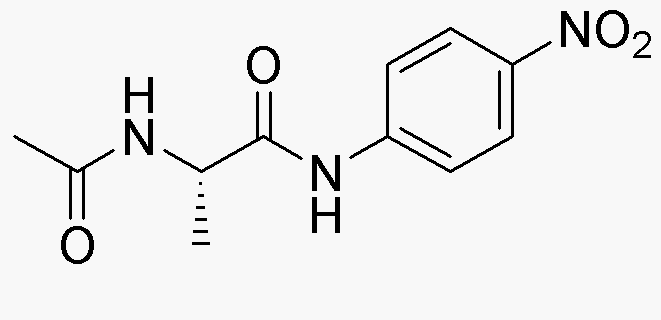Acetyl-L-alanine 4-nitroanilide is widely utilized in research focused on:
- Biochemical Assays: This compound serves as a substrate in enzyme assays, particularly for proteases, allowing researchers to measure enzyme activity effectively.
- Drug Development: Its properties make it valuable in the pharmaceutical industry for developing new drugs, especially those targeting specific enzyme pathways.
- Analytical Chemistry: It is used in chromatography and spectrophotometry for the analysis of amino acids and peptides, providing accurate quantification and characterization.
- Research on Protein Interactions: The compound aids in studying protein-ligand interactions, which is crucial for understanding biological processes and designing targeted therapies.
- Educational Purposes: It is often employed in academic laboratories for teaching students about enzyme kinetics and biochemical techniques, enhancing hands-on learning experiences.
Información general
Propiedades
Seguridad y normativas
Aplicaciones
Acetyl-L-alanine 4-nitroanilide is widely utilized in research focused on:
- Biochemical Assays: This compound serves as a substrate in enzyme assays, particularly for proteases, allowing researchers to measure enzyme activity effectively.
- Drug Development: Its properties make it valuable in the pharmaceutical industry for developing new drugs, especially those targeting specific enzyme pathways.
- Analytical Chemistry: It is used in chromatography and spectrophotometry for the analysis of amino acids and peptides, providing accurate quantification and characterization.
- Research on Protein Interactions: The compound aids in studying protein-ligand interactions, which is crucial for understanding biological processes and designing targeted therapies.
- Educational Purposes: It is often employed in academic laboratories for teaching students about enzyme kinetics and biochemical techniques, enhancing hands-on learning experiences.
Documentos
Hojas de datos de seguridad (HDS)
La SDS proporciona información de seguridad completa sobre la manipulación, el almacenamiento y la eliminación del producto.
Especificación del producto (PS)
La PS proporciona un desglose completo de las propiedades del producto, incluida la composición química, el estado físico, la pureza y los requisitos de almacenamiento. También detalla los rangos de calidad aceptables y las aplicaciones previstas del producto.
Certificados de análisis (COA)
Busque certificados de análisis (COA) ingresando el número de lote del producto. Los números de lote y de partida se pueden encontrar en la etiqueta de un producto después de las palabras "Lote" o "Lote".
Número de catálogo
Número de lote/lote
Certificados de origen (COO)
Este certificado de origen confirma el país en el que se fabricó el producto y también detalla los materiales y componentes utilizados en él y si se deriva de fuentes naturales, sintéticas u otras fuentes específicas. Este certificado puede ser necesario para cumplir con las normativas aduaneras, comerciales y regulatorias.
Número de catálogo
Número de lote/lote
Hojas de datos de seguridad (HDS)
La SDS proporciona información de seguridad completa sobre la manipulación, el almacenamiento y la eliminación del producto.
DownloadEspecificación del producto (PS)
La PS proporciona un desglose completo de las propiedades del producto, incluida la composición química, el estado físico, la pureza y los requisitos de almacenamiento. También detalla los rangos de calidad aceptables y las aplicaciones previstas del producto.
DownloadCertificados de análisis (COA)
Busque certificados de análisis (COA) ingresando el número de lote del producto. Los números de lote y de partida se pueden encontrar en la etiqueta de un producto después de las palabras "Lote" o "Lote".
Número de catálogo
Número de lote/lote
Certificados de origen (COO)
Este certificado de origen confirma el país en el que se fabricó el producto y también detalla los materiales y componentes utilizados en él y si se deriva de fuentes naturales, sintéticas u otras fuentes específicas. Este certificado puede ser necesario para cumplir con las normativas aduaneras, comerciales y regulatorias.


